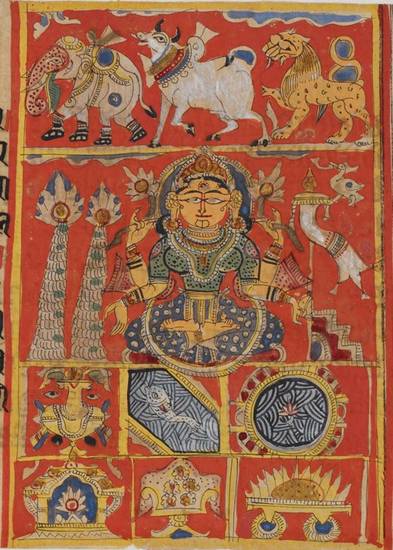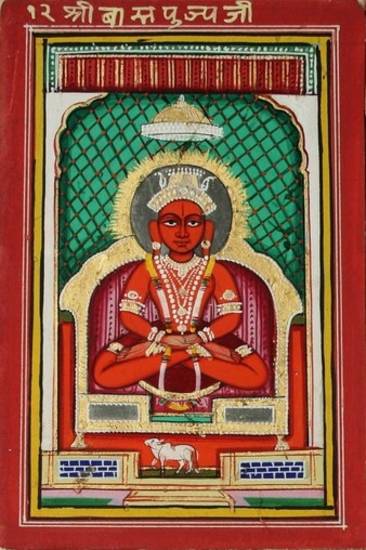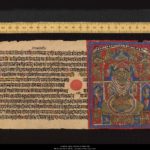Article: Vāsupūjya
Vāsupūjyanātha, Vāsupūjya-svāmin or Lord Vāsupūjya is the 12th of the 24 Jinas of the present cycle of time. The word Jina means ‘victor’ in Sanskrit. A Jina is an enlightened human being who has triumphed over karma through practising extreme asceticism and teaches the way to achieve liberation. A Jina is also called a Tīrthaṃkara or ‘ford-maker’ in Sanskrit – that is, one who has founded a community after reaching omniscience.
Vāsupūjya is not an historical figure. He is not singled out for individual biographies in the Śvetāmbara canonical scriptures. Treated like most of the other Jinas, he is provided only with basic biographical information. This information is fairly standardised and remains identical throughout later sources except for occasional variations, or confusions, in numbers.
The literal meaning of his name is he ‘who deserves to be worshipped by Vāsava’ – that is, the lord of gods, Indra, or ‘by the Vāsavas’. These are a category of Jain gods who intervene in the Jinas’ lives. Hence it has positive connotations referring to spiritual power, and also to brightness as vasu is a word for ‘sun’. The 12th Jina has the same name as his father – Vasupūjya.
The main difference between the accounts and descriptions of the Jinas’ lives among the two main Jain sects relates to whether they married or not. The general trend is that, according to Digambara biographies, the Jinas do not assume the responsibilities of a householder or king before becoming monks. The situation offered by Śvetāmbara sources is different, as the case of the 12th Jina demonstrates.
Vāsupūjya is one of the Jinas whose life is contemporary with a triad of great figures:
- the Baladeva Vijaya in Śvetāmbara sources, Acala in Digambara sources
- the Vāsudeva Dvipṛṣṭha
- the Prativāsudeva Tāraka.
Basic information
Each Jina has standard biographical information found in various sources. Among the earliest Śvetāmbara canonical sources that provide biodata of all the 24 Jinas is the final section of the fourth Aṅga, the Samavāyānga-sūtra and the Āvaśyaka-niryukti. Among the earliest Digambara sources is a cosmological work, the Tiloya-paṇṇatti.
The standard Digambara biography of Vāsupūjya is found on pages 87 to 96 of the 1968 edition of Guṇabhadra’s Uttarapurāṇa, composed in Sanskrit and Hindi. The standard Śvetāmbara biography is on pages 64 to 91 in volume III of Johnson’s English translation of Hemacandra’s work, Tri-ṣaṣṭi-śalākāpuruṣa-caritra.
The biographical data can be categorised in a standard manner, and includes numbers, which are significant in wider Indian culture. These standard details can also be used to identify individual Jinas in art, since they are usually depicted as stereotyped figures. Pictures or statues of Jinas present them in either the lotus position or the kāyotsarga pose. Both of these imply deep meditation.
Parents
The important feature of a Jina’s father is that he is a king, from the kṣatriyacaste.
A Jina’s mother has an important role because she gives birth to a future Jina, and in practice a Jina is often called ‘the son of X’. Another reason for her importance is that the names given to the various Jinas are said to originate either in pregnancy-whims or in a dream their mothers had, at least in Śvetāmbara sources. This dream is specific, and adds to the traditional auspicious dreams that foretell the birth of a child who will become a Jina.
In the case of Vāsupūjya, Hemacandra does not give any explanation for his name, which is derived from that of his father, Vasupūjya. The Āvaśyaka-niryukti, a Prakrit work from the first centuries of the Common Era, which gives an explanation for the names of the 24 Jinas, provides a literal analysis of the word. It is clearly a compound noun, meaning ‘the one who deserves to be worshipped by V.’ (verse 1085). Understanding of whom is designated as ‘V.’ differs because it can mean all of the following:
- the Vasus as a class of gods who intervene in the Jinas’ lives
- an equivalent of Vāsava, which in turn may refer to the lord of gods, Indra
- the god of riches, Kubera, since the word vasu means ‘riches’ or ‘treasures’.
These deities are then seen in relation to their behaviour when the Jina-to-be is in the womb of his mother, namely:
- Kubera demonstrated his devotion to the embryo by repeatedly filling the royal treasury with various gems
- Indra showed his devotion in his own way, which is not described further.
The Digambara author Guṇabhadra favours the understanding of ‘V.’ as referring to Indra.
|
Mother |
Father |
|---|---|
|
Jayā – Śvetāmbara |
Vasupūjya |
Places
Of the five auspicious events that mark a Jina’s life – kalyāṇakas – four take place on earth and are associated with a specific village or town in the sources. Archaeological evidence often helps to identify the old names with modern places. Even when it is lacking, there is a tendency to carry out this identification process. Associating auspicious events with certain locations makes these places sacred to Jains, so that they are potential or actual pilgrimage places and temple sites.
|
Last incarnation and birthplace |
||
|---|---|---|
|
Campā |
Campā |
Campā |
All the major events of Vāsupūjya’s life thus took place in Campā or Campāpurī. Its connection with the 12th Jina is recorded in the Vividha-tīrtha-kalpa, a 14th-century work on sacred places by the Śvetāmbara monk Jinaprabha-sūri.
Campā is modern Champapur, located 6 kilometres from the station of Bhagalpur, in Bihar, eastern India, near the Ganges river.
It is undoubtedly an old Jain site, since it is mentioned very often in the Śvetāmbara canonical scriptures as having been visited by various Jinas. Thus Vāsupūjya is one of those who are clearly rooted in the area that is the birthplace of Jainism. Champapur has a temple dedicated to him, with images. None of them, however, seems to be especially old.
About 40 kilometres to the south of Champapur lies the hill of Mandar-giri, where Vāsupūjya is said to have practised austerities, reached enlightenment and attained final liberation (Titze 1998: 202). This particular pilgrimage site is frequented more by Digambaras than members of the other main Jain sect.
Dates and numbers
The five auspicious events that mark a Jina’s life – kalyāṇakas – are traditionally associated with a specific date. This is given according to the system of the Indian calendar:
- month
- fortnight
- day in the fortnight.
Astrological considerations also play a role here and the texts normally mention the constellations when an auspicious event takes place.
|
Last incarnation |
Birth |
|||
|---|---|---|---|---|
|
ninth day of the bright half of Jyeṣṭha – Śvetāmbara |
14th day of the dark half of Phālguna |
new moon of Phālguna |
second day of the bright half of Māgha |
14th day of the bright half of Āṣāḍha – Śvetāmbara |
The dates associated with these events are potential or actual dates of commemoration. These may be marked in festivals, which determine the Jain religious calendar.
There may be variations in the dates in different sources, Śvetāmbara on one side, Digambara on the other. But there are also cases of differences within the same sectarian tradition.
There are also other numbers connected with the life of this Jina.
|
Height |
Total lifespan |
|---|---|
|
70 bows |
7,200,000 years |
Question of marriage
The main difference between the accounts and descriptions of the Jinas’ lives among the two main Jain sects relates to whether they married or not. According to the Digambaras, the Jinas did not assume the responsibilities of a householder or king before becoming monks. According to the Śvetāmbaras, some assume these responsibilities, while others did not. The life of Vāsupūjya shows diverging attitudes among Śvetāmbara sources.
The ninth-century Lives of the 54 Jain Great Men – Cauppaṇṇa-mahāpurisa-cariya – written in Prakrit by the Śvetāmbara monk Śīlānka, has a short biography of Vāsupūjya. Its account of his life is rather mechanically told and follows a repetitive pattern. The half-sentence devoted to his life as a young man says that he lived the life of a householder and of a king for some time.
In the 12th-century Śvetāmbara text Tri-ṣaṣṭi-śalākā-puruṣa-caritra, written by Hemacandra in Sanskrit, marriage is an issue. When he comes of age, Vāsupūjya’s parents request their son to marry, although they know he is reluctant to do so. Among the arguments his father puts forward is that of custom, followed by his predecessors:
The blessed Ṛṣabha [= first Jina], the first of the Ikṣvāku-family, married Sumangalā and Sunandā on his father’s advice. Just because of his father’s command, he took the kingdom and governed it, and adopted mendicancy at the right time, after enjoying pleasures [of the householder life]. The Lord attained emancipation afterwards by taking initiation. […] Others, from Ajita to Śreyāṃsa [= Jinas number two to 11], married, and supported the earth at their father’s advice and then attained emancipation. Do you do this. Follow your predecessors by accomplishing marriage, sovereignty, initiation, and nirvāṇa
Johnson’s translation, 1949, page 71
Vāsupūjya answers by referring to the theory of karmas, concluding that ‘there is no one path for the Arhats because of the difference in their karma’ (Johnson, page 71). His parents are unable to counter this point. Thus he is initiated without marrying.
In his argument, Vāsupūjya explains that Jinas who have karmas with pleasure as its fruit surviving in them must destroy these karmas by pleasure. Therefore they should marry. This, he says, applied to Jinas numbers two to 11, and will apply also to Jina number 24, Mahāvīra. He argues that, on the contrary:
Malli [= Jina number 19], Nemi [= Jina number 22] and Pārśva [= Jina number 23], three future Jinas, will become mendicants for the sake of emancipation, without marrying or ruling
Johnson, page 71
Monastic and lay communities
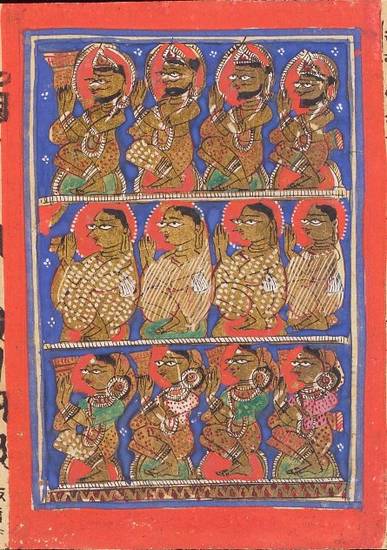
Fourfold community
Image by Wellcome Trust Library © Wellcome Library, London
A Jina is not an enlightened being who exists alone after reaching omniscience. After perfect knowledge comes general preaching – samavasaraṇa. This sermon, which is attended by all, is reported in the scriptures as resulting in large numbers of listeners being inspired. Many turn to religious life, becoming monks or nuns, while many others make the vows that lay people – śrāvaka and śrāvikā – can follow in their everyday lives. Further, the Jina’s teachings are preserved and passed on by his chief disciples – the gaṇadharas. This is why a Jina is also called a Tīrthaṃkara, meaning ‘ford-maker’ or ‘founder of a community’.
Each Jina establishes a ‘fourfold community‘, led by the chief disciples. Made up of monks, nuns, lay men and lay women, the fourfold community follows the principles the Jina has set out in his preaching. How members follow the religious teachings vary according to whether they remain householders or take initiation into mendicancy. Individual figures relating to each Jina are thus important.
|
Chief disciples |
Lay men |
Lay women |
||
|---|---|---|---|---|
|
66, led by Sūkṣma – Śvetāmbara |
72,000 |
100,000 led by Dharaṇīdharā – Śvetāmbara
|
215,000 – Śvetāmbara |
436,000 – Śvetāmbara |
Identification
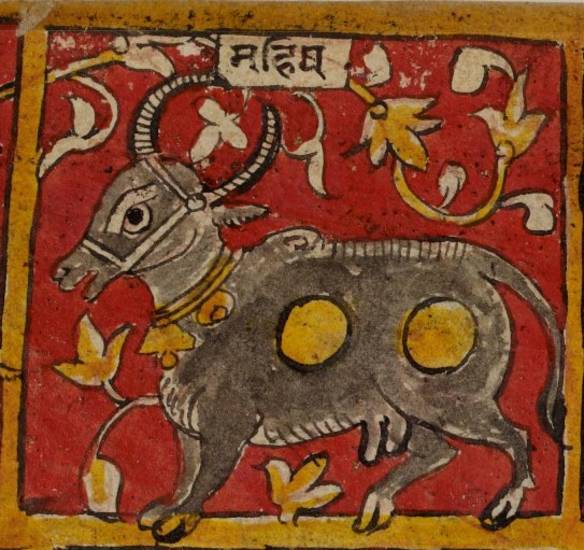
Buffalo
Image by British Library © CC0 1.0 (Creative Commons Public Domain)
All Jinas have individual emblems – lāñchanas – and colours that help to identify them in artwork. They also have deities in attendance, known as yakṣa and yakṣī, who often appear flanking them in art.
|
Colour |
Emblem |
||
|---|---|---|---|
|
red |
buffalo |
Kumāra |
Candrā – Śvetāmbara |
More details
Besides the basic information, the sources provide more details on various topics. These are almost infinite and vary depending on the sources. Such information differs between Śvetāmbaras and Digambaras. Here are only a few instances of extra detail.
All of the princes who become Jinas are carried on a palanquin to the park where they perform the ritual gesture of initiation into monastic life – dīkṣā. The palanquin of Vāsupūjya is named Pṛthivī. On this occasion, he is accompanied by numerous kings.
He performs a two-day fast. The next day he breaks his fast at the house of King Sunanda in the town of Mahāpura.
Vāsupūjya wanders for one month as an ordinary ascetic and reaches omniscience. According to the Śvetāmbaras, he is meditating under a pāṭalā tree when this occurs while the Digambaras say it is a kadamba tree.
Events, stories and hymns
The life of Vāsupūjya is almost eventless. In the ninth-century Lives of the 54 Jain Great Men – Cauppaṇṇa-mahāpurisa-cariya – written in Prakrit by the Śvetāmbara monk Śīlānka, the chapter about the 12th Jina is hardly a single page.
The 12th-century Sanskrit text Tri-ṣaṣṭi-śalākā-puruṣa-caritra, written by Hemacandra, has become the standard Śvetāmbara version of the Jinas’ lives and is somewhat longer. The 13th-century biography entitled Vāsupūjya-caritra is expanded with supplementary material.
Hemacandra’s text gives Vāsupūjya’s life more substance because the story of the triad of Vijaya, Dvipṛṣṭha and Tāraka is inserted within the general frame of the story and told at length. As usual with such triads, it is a tale of war and fighting. The two main enemies are the Vāsudeva Dvipṛṣṭha and the Prativāsudeva Tāraka, whose hatred continues from their previous births. In Śīlānka’s work, mentioned above, the story of the triad is an independent chapter located after the one devoted to the telling of Vāsupūjya’s life.
In the Digambara version by Guṇabhadra, the story of the triad also follows the narration of Vāsupūjya’s career. Here they are the:
- Baladeva Acala
- Vāsudeva Dvipṛṣṭha
- Prativāsudeva Tāraka.
Vāsupūjya-caritra
There are not so many sizeable biographies focusing on the 12th Jina. The most famous Śvetāmbara example is the Sanskrit Vāsupūjya-caritra. It was written in 1242 CE (1299 of the Vikrama era) by Vardhamāna, pupil of Vijayasiṃha-sūri, from the Nāgendra-gaccha. Containing more than five thousand verses in four chapters, it supplements the main career of Vāsupūjya with:
- numerous descriptions
- hymns
- sermons on the doctrine
- a large number of intervening stories illustrating, for instance:
- the notion of merit
- the importance of not eating during the night
- generosity
- moral restraints
- austerities
- meditation
- true doctrine
- the vows of the lay man.
- accounts of the previous births of Vāsupūjya.
The telling of the last life of Vāsupūjya starts as late as the third chapter.
A story relating the wrong behaviour of a nun called Meghamālā in the Mahā-niśītha-sūtra presents this nun as a contemporary of Vāsupūjya. This text is a scripture written in Prakrit that comes under or is associated with the class of the Cheda-sūtras. It does not provide further elaboration regarding Vāsupūjya (chapter 6, section 3h: Hamm and Schubring 1951: 10 and 23).
Hymns
Vāsupūjya is mainly praised alongside other Jinas in hymns dedicated to the 24 Jinas. One instance is the devotional song dedicated to this Jina in the Gujarati set of hymns composed by Yaśo-vijaya in the 17th century. This example can be found among the manuscripts digitised on JAINpedia.
Temples and images
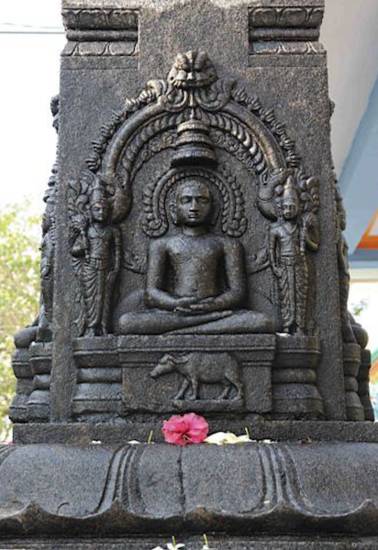
Sculpture of Vāsupūjya
Image by Ramesh Kumar © French Institute of Pondicherry
Vāsupūjya-svāmin or Lord Vāsupūjya is not one of the most popular Jinas. Yet he is known through a number of stone sculptures (Shah 1987: 148–149), such as:
- those in caves 8 and 9 at Khanda-giri, in Orissa
- an image of the seventh Jina accompanied by his yakṣa and yakṣī and shown with his buffalo emblem, from Shahdol, in Madhya Pradesh
- the figures in some temple cells at Mount Abu, Rajasthan
- those in some of the cells in the Pārśvanātha temple at Kumbharia, north Gujarat
- one in a niche of the Sambhavanātha temple at Kumbharia, dating from the late 13th century, depicting the Jina sitting under the campaka tree
- an image and inscription from Cambay, Gujarat, showing the Jina with a tree
- the standing image in the Bhaṇḍāra Basti at Shravana Belgola, where he is flanked by his yakṣa and yakṣī
- Digambara images in various temples of Karnatak, Madhya Pradesh and so on.
Among metal images showing Vāsupūjya, the big brass image worshipped in the temple of Marfatia Mehta, in Patan, north Gujarat, is noteworthy. It was installed in 1525, according to the inscription.
Reading
- Studien zum Mahānisīha
Frank-Richard Hamm and Walther Schubring - Alt- und Neu-Indische Studien series; volume 6
Seminar für Kultur und Geschichte Indiens an der Universität Hamburg; Hamburg, Germany; 1951
- Jaina Temple Architecture in India: The Development of a Distinct Language in Space and Ritual
Julia A. B. Hegewald - Monographien zur Indischen Archäologie, Kunst und Philologie series; volume 19
Stiftung Ernst Waldschmidt, G+H Verlag; Berlin, Germany; 2009
- Vividhatīrthakalpa
Jinaprabhasūri - edited by Muni Jinavijaya
Singhi Jain series; volume 10
Shantiniketan; Bombay, India; 1934
- The Jain Saga: 63 Illustrious Persons of the Jain World, Brief History of Jainism
Hemacandra - translated by Helen M. Johnson
edited by Muni Samvegayashvijayji Maharaj
Acharya Shrimad Vijay Ramchandra Suriswarji Jain Pathshala; Ahmedabad, Gujarat and Mumbai, Maharashtra, India; 2009
Links
- Vāsupūjya, the 12th Jina
-
Detail of an inscription and marble image of Vāsupūjya, the 12th Jina. From Cambay, Gujarat, this architectural fragment depicts the Jina and his attendants. The Digital South Asia Library at the University of Chicago in the USA provides this black-and-white photograph.
http://dsal.uchicago.edu/images/aiis/aiis_search.html?depth=Get+Details&id=81053
- Vāsupūjya and his attendants
-
An image of the 12th Jina Vāsupūjya accompanied by his yakṣa and yakṣī, the male and female deities who attend him and protect his teachings. The 12th Jina is shown meditating under a canopy at the centre of elephants, servants and lions, all symbols of royalty. He is surrounded by Jinas and other holy figures. Vāsupūjya's buffalo emblem is clear at the bottom of the sculpture in this photograph provided by the Digital South Asia Library at the University of Chicago in the USA.
http://dsal.uchicago.edu/images/aiis/aiis_search.html?depth=Get+Details&id=7446
- Vāsupūjya under a tree
-
Black-and-white photograph of Vāsupūjya, the 12th Jina, sitting under a tree in the lotus pose of meditation. The image is found in a niche of the Sambhavanātha temple at Kumbharia, and dates from the late 13th century. The Digital South Asia Library at the University of Chicago in the USA provides this photograph.
http://dsal.uchicago.edu/images/aiis/aiis_search.html?depth=Get+Details&id=69175
- Vāsupūjya temple in Champapur
-
Jainheritagecentres.com provides information about the Digambara temple in Champapur in Bihar, which is dedicated to the 12th Jina, Vāsupūjya. Background information about the surrounding area is also supplied.
https://www.jainheritagecentres.com/jainism-in-india/bihar/champapuri/
- Vāsupūjya temple
-
Information about the Digambara temple at Champapur in Bihar provided by the HereNow4U website. This site has long been a pilgrimage centre for devotees of the 12th Jina Vāsupūjya because all of his five auspicious events – kalyāṇakas – took place here.
- Possible shrine to Vāsupūjya
-
The Asian Art Museum of San Francisco presents five high-resolution images of a 15th-century metal shrine that may be dedicated to the 12th Jina, Vāsupūjya.
http://67.52.109.59:8080/emuseum/view/objects/asitem/id/19520
- +
- aAbhavya
- aAbhinandana
- aAbhiṣeka
- aĀcāra
- aĀcārāṅga-sūtra
- aĀcārya
- aAchalbhrata
- aAḍhāī-dvīpa
- aAdharma
- aAdho-loka
- aAdhyayana
- aAdvaita Vedānta
- aĀgama
- aAghātīya
- aAghātīya-karman
- aAgnibhuti
- aAgra
- aĀhāra
- aAhiṃsā
- aAhimsa Day
- aAjita
- aAjīva
- aAkampit
- aĀkāśa
- aAkbar the Great
- aAkṣaya-tṛtīyā
- aAlauddin Khalji
- aAlbert Einstein
- aAllah
- aAlms
- aĀlocanā
- aAloka-ākāśa
- aAmāri
- aAmbikā or Kūṣmāṇḍinī
- aAnagāra
- aAnanta
- aAnarthadaṇḍa
- aAnaśana
- aAnekānta-vāda
- aAṅga
- aAniconism
- aAnojjā
- aAntarāla
- aAntarāya-karma
- aAṇu
- aAṇu-vrata
- aAnukampā
- aAnuprekṣā
- aAnusvāra
- aApabhraṃśa
- aAparigraha
- aAra
- aĀrambha
- aĀrambhaja
- aĀratī
- aArdhamāgadhī Prākrit
- aArhaṃ
- aArhat
- aArśana-āvaraṇīya-karma
- aĀrta-dhyāna
- aĀryikā
- aĀryikā Jñānamati
- aĀśātanā
- aĀścarya
- aAscetic
- aAsceticism
- aAshram
- aAspiration
- aĀsrava
- aAṣṭa-maṅgala
- aAṣṭāpada
- aAstikāya
- aAstrolabe
- aAsura
- aAtheism
- aAticāra
- aAtiśayakṣetra
- aAtithisaṃvibhāgavrata
- aĀtma-vāda
- aĀtman
- aAuṃ
- aAurangzeb
- aAuspicious
- aAusterity
- aAvadhāna
- aAvadhi-jñāna
- aĀvaraṇī-yakarman
- aAvasarpiṇī
- aAvatāra
- aAvidyā
- aAxiom
- aĀyāga-paṭa
- aĀyambil
- aĀyu-karma
- aĀyurveda
- bBabur
- bBāhubali
- bBaladeva
- bBālāvabodha
- bBandha
- bBasadi
- bBazaar
- bBhadrankarvijay
- bBhagavant
- bBhaktāmara-stotra
- bBhakti
- bBhale
- bBharata
- bBhāṣā
- bBhāṣya
- bBhaṭṭāraka
- bBhāva
- bBhāva-pūjā
- bBhāvanā
- bBhavana-vāsin
- bBhavya
- bBhavyatva
- bBhaya
- bBhoga-bhūmi
- bBhogopabhoga
- bBodhi
- bBollywood
- bBrahmā
- bBrahma-deva
- bBrahmacārī
- bBrāhmaṇa
- bBraj Bhāṣā
- bBright fortnight
- bBritish Raj
- bBuddha
- bBuddhi-sagar
- bBuddhism
- bBuddhist
- cCaitya
- cCaityavāsin
- cCakravartin
- cCakreśvarī
- cCāmara
- cCandanā
- cCandragupta
- cCandraprabha
- cCanon
- cCāritra
- cCāritramohanīya-karman
- cCarũrī
- cCaste
- cCaturvidha-saṅgha
- cCaturviṃśati-stava
- cCāturyāma
- cCE
- cCelibacy
- cCha
- cChadmastha
- cChastity
- cCheda-sūtra
- cChristian
- cChristianity
- cClergy
- cCloning
- cColophon
- cCommentary
- cConch
- cConfession
- cCongregation
- cConsecration
- cCosmology
- cCremation
- cCrore
- cCult
- cCūrṇi
- dDādā-guru
- dDalit
- dDāna
- dDaṇḍa
- dDark fortnight
- dDarśana
- dDarśanamohanī-yakarman
- dDaśa-lakṣaṇa-parvan
- dDeity
- dDelhi Sultanate
- dDerāsar
- dDeśāvakāśika-vrata
- dDetachment
- dDevanāgarī
- dDevānandā
- dDevarddhi-gani
- dDevotee
- dDhamal
- dDhanuṣ
- dDhāra
- dDharma
- dDharma-dhyāna
- dDharma-sāgara
- dDharmastikaya
- dDhātakīkhaṇḍa
- dDholak
- dDhyāna
- dDiaspora
- dDig-vrata
- dDigambara
- dDīkṣā
- dDisciple
- dDīvālī
- dDivya-dhvani
- dDNA
- dDoctrine
- dDogma
- dDonor
- dDoṣa
- dDravya
- dDravya-pūjā
- dDrone
- dDuṣamā
- dDuṣamā-duṣamā
- dDuṣamā-suṣamā
- dDveṣa
- dDvīpa
- eEast India Company
- eEightfold Path
- eEkānta-vāda
- eEkendriya
- eElder
- eElders
- eEschatology
- eEtc up to
- fFarmān
- fFast
- fFatehpur Sikri
- fFestival
- fFestschrift
- fFiruz Shah
- fFly-Whisks
- fFolio
- fFour Noble Truths
- gGaccha
- gGaṇa
- gGaṇadhara
- gGanadharavada
- gGaṇeśa
- gGaṇin
- gGarba
- gGarbha
- gGarbha-gṛha
- gGaruḍa
- gGati
- gGene
- gGenomics
- gGhātī-yakarman
- gGhātīya
- gGhaznavid
- gGhiyasuddin Tughlaq
- gGhurid
- gGloss
- gGotra-karma
- gGujarāt
- gGujarati
- gGuṇa
- gGuṇa-sthāna
- gGuṇa-vrata
- gGupti
- gGuru
- gGuruṇī
- hHagiography
- hHajj
- hHaṃsa
- hHaribhadra
- hHariṇaigameṣin
- hHasta
- hHeresy
- hHiṃsā
- hHindi
- hHindu
- hHinduism
- hHīravijaya
- hHoroscope
- hHrīṃ
- hHumayun
- hHymn
- iIconoclasm
- iIconography
- iIdol
- iIndian Independence
- iIndology
- iIndra
- iIndrabhūti Gautama
- iIndriya
- iInitiation
- iIntercession
- iInvocation
- iIQ
- iIslam
- iIslamicate
- iIṣṭadevatā
- iĪśvara
- jJagat
- jJahangir
- jJain
- jJaina Devanāgarī
- jJaina Śaurasenī
- jJaina-dharma
- jJainaśāsana
- jJainness
- jJaisalmer
- jJamāli
- jJambū-dvīpa
- jJames Burgess
- jJanma
- jJanma-kalyāṇa
- jJarā
- jJāti
- jJina
- jJina-āgama
- jJina-bhavana
- jJina-bimba
- jJina-mātā
- jJinacandra-sūri
- jJinadatta
- jJinaprabha
- jJīva
- jJñāna
- jJñāna-āvaraṇīya-karma
- jJñāna-āvarṇiya
- jJñānsundar
- jJyotiṣka
- kKāla
- kKālakācārya-kathā
- kKālidāsa
- kKalpa-sūtra
- kKalpa-vṛkṣa
- kKalyāṇaka
- kKalyanvijay
- kKamaṇḍalu
- kKamaṭha
- kKarma
- kKarma-bhūmi
- kKarma-grantha
- kKarma-prakṛti
- kKarma-vāda
- kKarmon
- kKarnataka
- kKaṣāya
- kKathā
- kKāvya
- kKāya
- kKāyotsarga
- kKeśa-loca
- kKetu
- kKevala-jñāna
- kKevalin
- kKhalji
- kKharatara-gaccha
- kKnowledge
- kKriyā
- kKriyā-vāda
- kKṛṣṇa
- kKṣamā-śramaṇa
- kKṣapakaśreṇi
- kKṣatriya
- kKṣullaka
- kKulakara
- kKundakunda
- kKunthu
- lLabdhi
- lLaity
- lLakh
- lLāñchana
- lLands of Action
- lLaukāntika
- lLavaṇa-samudra
- lLeśyā
- lLiṅga
- lLinguistics
- lLoka
- lLoka-ākāśa
- lLoka-puruṣa
- lLoka-vāda
- lLotus
- lLotus lake
- mMadhya-loka
- mMahā-videha
- mMahā-vrata
- mMahābhārata
- mMahāmastakābhiṣeka
- mMāhārāṣṭra
- mMāhārāṣṭrī Prākrit
- mMahattarā Yākinī
- mMahāvīr Jayantī
- mMahāvīra
- mMakāra
- mMakkhali Gośāla
- mMalli
- mMāna-stambha
- mManaḥ-paryāya-jñāna
- mMaṇḍala
- mMaṇḍapa
- mMandit
- mMaṅgala
- mMantra
- mMantras
- mManuṣya-loka
- mMarāṭhī
- mMārgaṇā
- mMartyr
- mMarudevī
- mMaṭha
- mMati-jñāna
- mMauryaputra
- mMecca
- mMendicant lineage
- mMetarya
- mMiracle
- mMithyādṛṣṭi
- mMohandas Gandhi
- mMohanīya-karma
- mMokṣa
- mMonastic order
- mMonasticism
- mMonk
- mMonotheism
- mMosque
- mMount Meru
- mMount Sammeta
- mMṛgāvatī
- mMughal
- mMuhammad
- mMuhammad bin Tughlaq
- mMuhpattī
- mMūla-sūtra
- mMūlaguṇa
- mMumbaī
- mMuni
- mMunisuvrata
- mMurad Bakhsh
- mMūrti-pūjaka
- mMuslim
- mMysticism
- nNābhi
- nNāga-kal
- nNāgapurīya Tapā-gaccha
- nNāgarī
- nNāma-karma
- nNamaskāra-mantra
- nNami
- nNandīśvara-dvīpa
- nNandivardhana
- nNandyāvarta
- nNāraka
- nNāraki
- nNasalisation
- nNātha
- nNavrātrī
- nNaya-vāda
- nNemi
- nNidāna
- nniggaṃthāṇa vā 2
- nniggaṃtho vā 2
- nNigoda
- nNihnava
- nNikṣepa
- nNirgrantha
- nNirjarā
- nNirvāṇa
- nNiryukti
- nNiṣidhi
- nNitya
- nNiyati
- nNo-kaṣāya
- nNudity
- nNun
- oOcean of milk
- oOmniscience
- oOrdination
- ppa°
- pPadmaprabha
- pPadmāsana
- pPadmāvatī
- pPādukā
- pPalanquin
- pPalette
- pPañca-muṣṭi
- pPāṇḍava
- pPaṇḍit
- pPandit Dalsukh D. Malvania
- pPandit Sukhlalji
- pPāṇipātra
- pPāpa
- pParamātman
- pParameṣṭhin
- pPāraṇā
- pParigraha
- pPariṇāma
- pParīṣaha
- pParokṣa
- pPārśva
- pPārśvanātha
- pParyāya
- pParyuṣaṇ
- pPaṭa
- pPatan
- pPātra
- pPenance
- pPersian
- pPhala
- pPhilology
- pPicchikā
- pPilgrimage
- pPīr
- pPolymath
- pPoṣadha
- pPossession
- pPothī
- pPrabhas
- pPradakṣiṇā
- pPradeśa
- pPrākāra
- pPrakīrṇaka-sūtra
- pPrākrit
- pPramāda
- pPramukhā
- pPrati-vāsudeva
- pPratikramaṇa
- pPratimā
- pPratiṣṭhā
- pPratyākhyāna
- pPratyakṣa
- pPravacana
- pPrāyaścitta
- pPrayer
- pPre-modern
- pPreach
- pPredestination
- pProtestant
- pProvenance
- pPudgala
- pPūjā
- pPujārī
- pPukharavara-dvīpa
- pPuṇya
- pPūrva
- pPuṣkara-dvīpa
- pPuṣpadanta
- pPyre
- qQur’an
- rRāga
- rRāhu
- rRainy season
- rRajasthan
- rRajasthani
- rRājimatī
- rRajoharaṇa
- rRajput
- rRāma
- rRāmāyaṇa
- rRangoli
- rRās-garbā
- rRasa
- rRathanemi
- rRatna-traya
- rRātri-bhojana
- rRaudra-dhyāna
- rRecto
- rRelic
- rRenunciation
- rRetroflex
- rRevatī
- %Ṛg-veda
- rRite
- rRosary
- %Ṛṣabha
- %Ṛṣabhanātha
- rRupee
- sSaciyā Mātā
- sSādhu
- sSādhvī
- sSāgāra
- sSaint
- sŚaivaism
- sŚaka-saṃvat
- sSallekhanā
- sŚalya
- sSamacatuṣṭha
- sSamādhimaraṇa
- sSamaṇi
- sSāmarambha
- sSamavasaraṇa
- sSāmāyika
- sSaṃbhava
- sSamiti
- sSaṃjñā
- sSaṃkalpaja
- sSaṃsāra
- sSamudghāta
- sSaṃvara
- sSaṃvega
- sSamyak-cāritra
- sSamyak-darśana
- sSamyak-jñāna
- sSamyaktva
- sSaṃyama
- sSanctuary
- sSandalwood
- sSaṇgha
- sSanskrit
- sSant
- sŚānti
- sSapta-bhaṅgi-naya
- sSārambha
- sSarasvatī
- sSarvajña
- sSāsan-devi
- sŚāsana-devatā
- sŚāstra
- %Ṣaṭ-jīvanikāya
- sSatī
- sSatīmātā
- sSatya
- sSchism
- sScribe
- sScripture
- sSect
- sSecularism
- sŚenāī
- sSermon
- sŚeṣavatī
- sSevā
- sSeven fields of donation
- sShah Jahan
- sShantidas Jhaveri
- sShrine
- sSiddha
- sSiddha-śilā
- sSiddhacakra or Navadevatā
- sSiddhānta
- sSiddhārtha
- sSiddhi
- sSikh
- sSikhism
- sŚikṣā-vrata
- sŚīla
- sSin
- sSindh
- sŚītala
- sŚiva
- sSkandha
- sSomanatha
- sŚraddhā
- sŚramaṇa
- sŚrāvaka
- sŚrāvakācāra
- sŚrāvikā
- sŚreyāṃsa
- sŚrī
- sŚrīvatsa
- sŚruta-jñāna
- sŚruta-pañcamī
- sSthānaka-vāsin
- sSthāpanācārya
- sSthāvara
- sSthavira
- sSthiti
- sStrīmukti
- sStūpa
- sSubcontinent
- sSudarshana
- sŚuddhi
- sSudharma
- sŚūdra
- sSufism
- sSukha
- sŚukla-dhyāna
- sSulasā
- sSultan
- sSumati
- sSundarśrī
- sSupārśva
- sSūri
- sSuṣamā
- sSuṣamā-duṣamā
- sSuṣamā-suṣamā
- sSūtra
- sSuyam me ausam! Tenam bhagavaya evamakkhayam
- sSvādhyāya
- sSvāhā
- sSvastika
- sŚvetāmbara
- sŚvetāmbara Terāpanthin
- sŚvetāmbaras
- sSwan
- sSyād-vāda
- tTabla
- tTantra
- tTapā-gaccha
- tTapas
- tTāraṇ Svāmī Panth
- tTattva
- tTattvārtha-sūtra
- tTemple
- tTemple-city
- tThe Enlightenment
- tTheology
- tThree worlds
- %Ṭīkā
- tTilaka
- tTīrtha
- tTīrthaṃkaranāma-karman
- tTīrthankara
- tTransliteration
- tTrasa
- tTrasa-nāḍī
- tTriśalā
- tTriṣaṣṭi-śalākā-puruṣa-caritra
- tTti bemi
- tTughlaq
- tTunk
- uUdumbara
- uUniversal History
- uUpādhyāya
- uUpāṅga
- uUpaniṣads
- uUpāsaka
- uUpasarga
- uUpāśraya
- uŪrdhva-loka
- uUtsarpiṇī
- uUttarādhyayana-sūtra
- vVāhana
- vVaimānika
- vVairāgya
- vVaiṣṇava
- vVaiśramaṇa
- vVaiśya
- vValabhī
- vVanaspatikāya
- vVandana
- vVaṇik
- vVarṇa
- vVāsudeva
- vVāsupūjya
- vVayubhūti
- vVeda
- vVedanīya-karma
- vVegetarianism
- vVehicle
- vVernacular
- vVerso
- vVidyā
- vVidyā-devī
- vVihāra
- vVijñapti-patra
- vVikrama-saṃvat
- vVikṛti
- vVimala
- vVinaya
- vVipāka
- vVirji Vora
- vVirodhaja
- vVīrya
- vVisarga
- vViṣṇu
- vVītarāga
- vVizier
- vVotive
- vVow
- vVrata
- vVS
- vVyakta
- vVyantara
- vVyasana
- yYakṣa
- yYakṣī
- yYantra
- yYaśoda
- yYaśovijaya
- yYati
- yYātrā
- yYoga
- yYoginī
- yYojana



